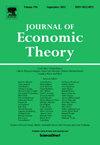内幕交易与连续时间处罚
IF 1.2
3区 经济学
Q3 ECONOMICS
引用次数: 0
摘要
本文讨论了在连续时间凯尔模型中,内幕人士如何内化交易的额外惩罚。处罚可以解释为非逆向选择交易费用,也可以解释为非法内幕交易的法律处罚。建立了一般资产分配的均衡。在均衡状态下,内部人不会将其私人信息完全传播到市场价格中。此外,在她的私人信息公开之前,她总是以自己的估值与她对市场价格的预测之差的常数倍进行交易。在资产价值为正态分布的特殊情况下,如果惩罚足够大,交易将随着时间的推移平均分割,交易规模与私人信号的回报成正比。虽然噪声交易者在惩罚增加时损失较小,但均衡下内幕人的总惩罚是非单调的,因为当惩罚超过私人信号的值时,内幕人的交易很少。因此,预算有限的监管机构只有在调查的收益足够高的情况下才会进行调查。此外,最优惩罚政策被简化为从对应于高流动性和低流动性制度的两个极端惩罚水平中选择一个。最优选择由噪声交易的数量和价格信息的相对重要性决定。本文章由计算机程序翻译,如有差异,请以英文原文为准。
Insider trading with penalties in continuous time
This paper addresses the question of how insiders internalize the additional penalties to trade in a continuous time Kyle model. The penalties can be interpreted as non-adverse selection transaction costs or legal penalties due to illegal insider trading. The equilibrium is established for general asset distribution. In equilibrium, the insider does not disseminate her private information fully into the market prices. Moreover, she always trades a constant multiple of the discrepancy between her own valuation and her forecast of market price right before her private information becomes public. In the particular case of normally distributed asset value, the trades are split evenly over time for sufficiently large penalties, with trade size proportional to the return on the private signal. Although the noise traders lose less when penalties increase, the insider's total penalty in equilibrium is non-monotone since the insider trades little when the penalties surpasses the value of the private signal. As a result, a budget-constrained regulator runs an investigation only if the benefits of the investigation are sufficiently high. Moreover, the optimal penalty policy is reduced to choosing from one of two extremal penalty levels that correspond to high and low liquidity regimes. The optimal choice is determined by the amount of noise trading and the relative importance of price informativeness.
求助全文
通过发布文献求助,成功后即可免费获取论文全文。
去求助
来源期刊

Journal of Economic Theory
ECONOMICS-
CiteScore
2.50
自引率
12.50%
发文量
135
期刊介绍:
The Journal of Economic Theory publishes original research on economic theory and emphasizes the theoretical analysis of economic models, including the study of related mathematical techniques. JET is the leading journal in economic theory. It is also one of nine core journals in all of economics. Among these journals, the Journal of Economic Theory ranks fourth in impact-adjusted citations.
 求助内容:
求助内容: 应助结果提醒方式:
应助结果提醒方式:


